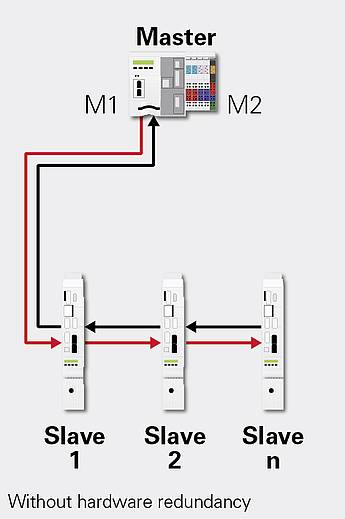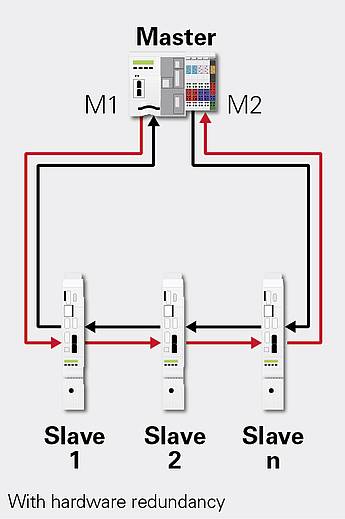Topology
Sercos networks consist of a master which coordinates and at least one slave which carries out automation functions. Generally, the devices are ordered simply and neatly in line or ring topologies. For this purpose, each Sercos device has two communication ports which are connected to the previous and subsequent device via an Ethernet cable – either using a twisted two-wire line (twisted pair) or an optical fiber. As a result of full duplex-enabled Ethernet technology, a logical ring appears in a line topology and a logical double ring appears in a ring topology (see image).
 |
 |
You'll find useful webinar recordings about Topology in our Downloads section.
In a line topology, the master is positioned at the beginning of a line or between two lines. The telegrams containing data run through the slaves and are ‘looped back’ by the last device. All devices analyze the data running in both directions so that all data is guaranteed to reach each device within the cycle independent of the order they are placed in. In this way, all devices can be integrated into the network, even across long distances, e.g. assembly lines, without high installation costs.
By adding an additional cable, the Sercos network closes to form a ring; a line is added between the last slave and the master, or between the last slaves. The master feeds the ring in opposite directions over both ports so that the data is also analyzed in two directions in the ring. In addition to having all the benefits of a line topology, ring topology provides additional redundant cabling. This means that a break in the ring can be compensated for without losing synchronization or causing a breakdown in communication.
Single devices or machine modules can also be connected to a line or ring via a branch line or a transmission line. To achieve this, either an infrastructure component with the appropriate branch line ports is integrated into the network or this function is directly integrated into the Sercos device. Sercos also supports hierarchical, cascading network structures. At the same time, individual network segments are connected to each other via Sercos allowing network structures to be created which are connected in real-time and that are completely synchronized. Cycle times in single segments can be different, e.g. 250 μs for connecting drives and fast I/Os, and 2 ms for connecting control systems. Devices across the entire network can communicate with each other in real-time. Moreover, all devices across the entire network are guaranteed to be synchronized.